Fumbles
New member
I've been treating a uroplatus fimbriatus for a mouth wound for about a week now. The issue was a mouth wound that was getting worse. Now his wound is healing rather nicely but he's not eating and he's sleeping in odd spots. I've always known a uroplatus to sleep vertically, feet straight up and down and tail covering. Lately he's taken to sleeping on top of one of the dracena tree with the leaves, sort of sprawled across them but with a good grip on the leaves.
I have an idea of why he stopped eating and sleeps in the same odd place. I have never handled him this much in his life - I'm usually at about once every two weeks to 1 month just to inspect him, but for the past eight days I'd taken him out of his enclosure every single morning for 10 minutes to clean and dress his wound, then place him on a vertical stick where he usually stays straight up and down..
I'm not sure what's going on here. He seems otherwise healthy and strong, but I'm noticing in the morning I'm taking the same amount of crickets out as I put in the night before.
I'm going to try something Jadrig mentioned which was calcium powder mixed with baby food to get him eating - just for SOME nutrition. I don't need him crashing. I also have a pair of rather large adult dubia roaches that I tried to feed him a while back, I might give that a shot in a clear deli tray so he can hear and see them scuttle around. He seems to have lost interest in the crickets I've been feeding him for the past 4 years.
Anyone have input on my theory about the hunger strike and my solution?
I have an idea of why he stopped eating and sleeps in the same odd place. I have never handled him this much in his life - I'm usually at about once every two weeks to 1 month just to inspect him, but for the past eight days I'd taken him out of his enclosure every single morning for 10 minutes to clean and dress his wound, then place him on a vertical stick where he usually stays straight up and down..
I'm not sure what's going on here. He seems otherwise healthy and strong, but I'm noticing in the morning I'm taking the same amount of crickets out as I put in the night before.
I'm going to try something Jadrig mentioned which was calcium powder mixed with baby food to get him eating - just for SOME nutrition. I don't need him crashing. I also have a pair of rather large adult dubia roaches that I tried to feed him a while back, I might give that a shot in a clear deli tray so he can hear and see them scuttle around. He seems to have lost interest in the crickets I've been feeding him for the past 4 years.
Anyone have input on my theory about the hunger strike and my solution?
Last edited:


